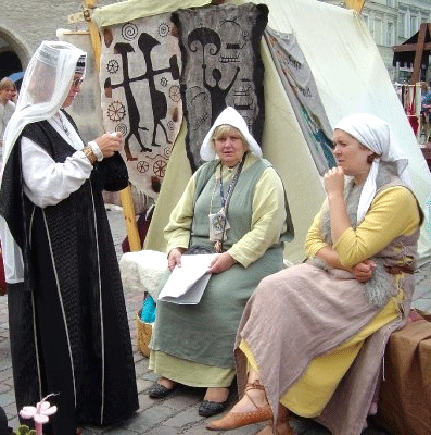Baltic Cities, Part III: Tallinn and Copenhagen
BY DERYA SONER (MBG/IV)
a_soner@ug.bilkent.edu.tr
The most interesting part of Tallinn is the old town, which is so unbelievably well preserved that it makes you feel like you have time-travelled into medieval times. When you are walking on the cobblestone roads, you will be surrounded by stone buildings and people dressed up in medieval costumes. The salespeople in the public market are all dressed up in medieval clothes; women are dressed in "kirtles" and the men wear tunics, cloaks, and leather vests. You can even see a priest walking around in a brown cloak and a rope around his waist. The market is a great place to shop for clothes and accessories made of linen, wool, and leather. There is also a stage where Estonians perform folk dances and music with wooden flutes and other regional instruments; this is probably done all day throughout the summer when the market is swarming with tourists.
Tallinn is the capital and the largest city of Estonia with a population of a surprisingly small 410,000. Accordingly, most towns of Estonia are reminiscent of the cute little town pictured in the old cartoon series "Heidi." The total population of Estonia is 1.34 million, but despite its small size, Estonia is economically in a much better state compared to its neighbors and other former Soviet nations and is now more often considered a Nordic country along with more developed countries such as Norway and Sweden.
 When you enter Copenhagen, the most striking thing is perhaps the variety and beauty of the architecture; you are surrounded by crimson buildings with remarkable features such as pointed roofs and amazing window pieces. There are also very modern samples of architecture where steel, wood, and glass are used in unique combinations. If you take a boat ride on the canal, you will also see that some parts of the city contain blocks of buildings that look very Dutch. Interestingly, there is an area of the city where hippies live in deserted remains of old buildings. There are also a lot of very beautiful green gardens, and lots of statues of Greek gods, goddesses, and Danish heroes. Speaking of Danish, do not forget to taste Danish pastries in their hometown!
When you enter Copenhagen, the most striking thing is perhaps the variety and beauty of the architecture; you are surrounded by crimson buildings with remarkable features such as pointed roofs and amazing window pieces. There are also very modern samples of architecture where steel, wood, and glass are used in unique combinations. If you take a boat ride on the canal, you will also see that some parts of the city contain blocks of buildings that look very Dutch. Interestingly, there is an area of the city where hippies live in deserted remains of old buildings. There are also a lot of very beautiful green gardens, and lots of statues of Greek gods, goddesses, and Danish heroes. Speaking of Danish, do not forget to taste Danish pastries in their hometown!
Another very beautiful thing about Copenhagen is that everybody is on bikes - 37 percent of the population ride their bikes every day. Mothers carry their kids in a cart behind their bikes or in a chair in front of the bike, couples ride double bikes, and many people go to work on their bikes in their suits and with their suitcases. The people of Denmark must be incredibly environment-friendly, as one can also see many giant metallic windmills around the city, which revolve to produce clean energy.
The famous Little Mermaid Statue sitting on a stone by the ocean is disappointingly small with a size of only 1.25 meters. Interestingly, the statue was commissioned by the son of the founder of Carlsberg brewery, who was fascinated by a ballet and asked the prima ballerina to model for the statue. The Carlsberg group also had a major influence on art: the Glyptotek museum in the center of the city contains art from Van Gogh, Rodin, Manet, and Cézanne, which were collected by the Jacobsen family who founded Carlsberg. There is also a large amusement park in the city center called Tivoli Gardens, which is also home to a lot of concerts and is the oldest amusement park in Europe.
Our tour of the Baltic cities ends here, hope you enjoyed the ride!